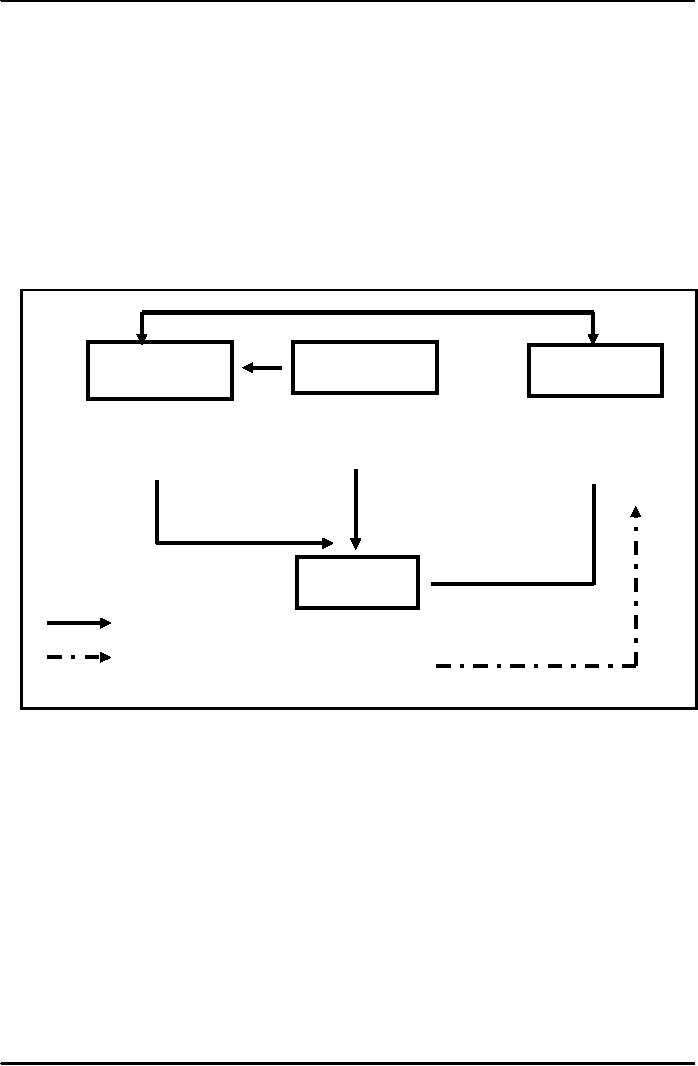 |

Introduction
To Public
AdministrationMGT111
VU
LESSON
36
TEAM
II
At the
end of lecture the students
will be able to
understand:
-
What are team
norms;
-
Understand
team cohesiveness;
-
Methods
to increase team
cohesiveness
-
Meaning
and concept of communication
Team
Norms
When
group members work together they
form expectations about how
they and the other
members
will behave. Some of these
norms are carried over
from society in general,
such as dressing
"properly'"
for work or showing up on time.
Others are particular to the group
and its special goals,
such as
questioning
"conventional ideas".
When
an individual breaks with
team norms, the other
members will probably
pressure that
individual
to conform. Team norms are
therefore important to adhere to by the
team/group members.
Without
the understanding of norms and adherence
to norms groups cannot
function.
Team
Cohesiveness
The
solidarity, or cohesiveness, or
togetherness of team member is an
important indicator of
how
much
influence the group has over
its individual members. The
more cohesive the group-the
more strongly
members
feel about belonging to it and the
greater its influence. If the members of
a group feel strongly
attached
to it, they are not likely
to violate its norms.
Team
cohesiveness plays a role in
small as well as large organization in
better performance. Team
cohesiveness
is critical in helping the individual feel
good about his or her
contribution to the effort as
well.
Highly
cohesive teams often have
less tension and hostility
and fewer misunderstanding
than less cohesive
groups.
Four
ways to Cohesiveness
Cohesiveness
or solidarity in teams can be achieved by
adopting certain measures.
Some of the
methods
are:
1.
Introduce
competition;
2.
Increase
interpersonal attraction;
3.
Increase
interaction; and
4.
Create
common goals and common fates
for employees
1.
Introduce
Competition: When
the competition with outside
individuals or other teams
is
increased,
the group becomes cohesiveness.
When the group feels outside
threat or competition
from
outside the rational response of
members is to develop
cohesiveness.
2.
Increase
Interpersonal Attraction: Sometimes
people join teams whose
members they identify
with
or admire. Thus, an organization may want
to begin by trying to attract employees
who share
certain
key values or who have
common goals.
3.
Increase
Interaction: In
work situation it is not
often possible for people to
like everyone they
work
with. However, it has been
observed that when people interact
frequently with each
other,
there
is gradual likeness that people develop.
Increased interaction and
communication can
improve
camaraderie.
4.
Create
Common Goals And Common
Fates: A
group's effectiveness is a function of
three
variables:
i.
Task interdependence,
ii.
Potency, and
iii.
Outcome interdependence.
129

Introduction
To Public
AdministrationMGT111
VU
i.
Task
interdependence relates
to the dependence of workers on one
group
member
on the work of another member. E.g.
one group member's task is
to
straighten
wire while the other group
member has to cut the wire, so once the
wire
is
cut the first worker has to
round the head of wire. This is
task interdependence.
ii.
Group's
sense of potency means,
shared belief of a group
that it can be effective.
The
group potency also keeps the
group together.
ii.
Outcome
interdependence is the
degree to which the consequences of
the
group's
work are felt by all the
group's members. In other words the
group
members
have a feeling that the outcome of
group efforts is not
possible without
each
one contributing. And that
the success of group is every
member's success.
All
the three factors that
create common goals and fate
are shown in Figure 1.
Determinants
of Work-Group Effectiveness
Figure
1
Outcome
Task
Potency
Interdependence
Interdependence
(Effectiveness)
Identifying factors
Identifying factors
Identifying
factors
Include
organizational
Include
organizational
Include
technology,
Strategic
plan,
Reward,
recognition,
Work
rules, proximity of
History,
culture
members
Group
Task
Effectiveness
=
Effect
Identifying
factors include
=
Feedback
Organizational
criteria
For
effectiveness
Making
Teams Effective
Many
managers' joke or complaint
about committees and
meetings of teams being big
time-
wasters.
In reality, a committee or task force or
a group is often the best
way to pool the
expertise
of
different members of the organization and
channel their efforts
towards effective problem
solving
and decision making. This is done by
coordinating the efforts of group in
effective manner.
Guidelines
for Making Committees and Meeting
Effective
Committees
differ greatly in their
functions and activities, therefore
set of broad guidelines
will
appropriate
for all cases are
recommended. The following
suggestions apply to committees, and
group
meetings,
if the skills of members are to be
used most effectively:
1.
The
agenda and all supporting
material for the meeting should be
distributed to members
before
the meeting to give them time to prepare in
advance.
2.
Meetings
should start and end on time.
The time when they will end
should be announced
at
the outset.
130

Introduction
To Public
AdministrationMGT111
VU
3.
The
committee's authority should be known
i.e., Is the committee to advise,
recommend
or
implement
4.
Chairperson
should be selected on his/her ability to
run meetings
efficiently
5.
Optimum
size of committee should be determined.
If the members are too few
members
i.e.
fewer than five the advantage of
committee may be diminished. Similarly if the
size is
too
large even then best of the
group may not be utilized.
However, size may
vary
according
to the task assigned to group.
Communication
Another
important area of organization and
for manager's effectiveness is
Communication.
Communication
is the back bone of organization's survival and
growth. Organizations must be able to
pass
on
their mission
goals and
Objectives
effectively
to all members of organization. The
communication is
also
important because all
managerial activities and functions
like motivation, leadership, teamwork
etc., are
dependent
on communication. Without communication it is not
possible to run the organization
effectively
and
efficiently
What
is communication
Communication
is defined as the transmission of
information/ message (written or verbal)
from
one
person to another or from one
place to other.
The
Importance of Effective
Communication
Effective
communication is important for following
reasons:
1.
Communication provides a common thread for the
management processes of planning,
organizing,
leading,
and controlling, team work,
etc.
2.
Effective communications skills
can enable managers to draw
on the vast array of talents
available
in
organization.
3.
Managers do spend a great
deal of time communicating. Rarely
are managers alone at their
desks
thinking,
planning, or contemplating alternatives. In
fact, managerial time is spent
largely in face-to-
face,
electronic, or telephonic communication with
employees, supervisors, suppliers or
customers
etc.
Interpersonal
Communication
Communication
is defined as the process by which people
seek to share meaning via
the
transmission
of symbolic messages. The
definition of communication has three
essential points. These
are:
(1)
Communication
involves people, and communication involves trying to
understand how
people
relate to each other;
(2)
Communication
involves shared meaning,
which suggests that in order
for people to
communicate,
they must agree on the definitions of the
terms they are using;
and
(3)
Communication
involves symbols, gestures,
sounds, letters, numbers,
words etc. And
language
can only represent or approximate the
ideas that they are meant to
communicate.
Concepts
Team
cohesiveness:
Solidarity,
together of members of group.
Task
interdependence:
The
tasks assigned to members in
group are
interdependence.
Outcome
interdependence:
The
outcome or result of group
activity is the result of effort
of
all
members and all members
share the reward or take
pride in
the
result.
Potency
effectiveness:
Every
member in a group contributes effectively
to achieve
results.
Communication:
Transmission
of information/message (written and
verbal)
from
one person to other.
131
Table of Contents:
- INTRODUCTION:Institutions of State, Individualism
- EVOLUTION OF PUBLIC ADMINISTRATION:Classical School, The Shovelling Experiment
- CLASSICAL SCHOOL OF THOUGHTS – I:Theory of Bureaucracy, Human Relation Approach
- CLASSICAL SCHOOL OF THOUGHTS – II:Contributors of This Approach
- HUMAN RELATIONS SCHOOLS:Behavioural School, System Schools
- POWER AND POLITICS:Conflict- as Positive and Negative, Reactions of Managers, Three Dimensional Typology
- HISTORY OF PUBLIC ADMINISTRATION – I:Moghul Period, British Period
- HISTORY OF PUBLIC ADMINISTRATION – II
- CIVIL SERVICE:What are the Functions Performed by the Government?
- CIVIL SERVICE REFORMS:Implementation of the Reforms, Categories of the Civil Service
- 1973 CONSTITUTION OF PAKISTAN:The Republic of Pakistan, Definition of the State
- STRUCTURE OF GOVERNMENT:Rules of Business, Conclusion
- PUBLIC AND PRIVATE ADMINISTRATION:The Public Interest, Ambiguity, Less Efficient
- ORGANIZATION:Formal Organizations, Departmentalization
- DEPARTMENTALIZATION:Departmentalization by Enterprise Function, Departments by Product
- POWER AND AUTHORITY:Nature of Relationship, Delegation of Functional Authority
- DELEGATION OF AUTHORITY:The Art of Delegation, Coordination
- PLANNING – I:Four Major Aspects of Planning, Types of Plans
- PLANNING – II:Planning ProcessThree principles of plans
- PLANNING COMMISSION AND PLANNING DEVELOPMENT:Functions, Approval Authority
- DECISION MAKING:Theories on Decision Making, Steps in Rational Decision Making
- HUMAN RESOURCE MANAGEMENT (HRM):Importance of Human Resource, Recruitment
- SELECTION PROCESS AND TRAINING:Levels at Which Selection takes Place, Training and Development
- PERFORMANCE APPRAISAL:Formal Appraisals, Informal Appraisals
- SELECTION AND TRAINING AND PUBLIC ORGANIZATIONS:Performance Evaluation,
- PUBLIC FINANCE:Background, Components of Public Finance, Dissimilarities
- BUDGET:Components of Public Income, Use of Taxes, Types of Taxation
- PUBLIC BUDGET:Incremental Budget, Annual Budget Statement, Budget Preparation
- NATIONAL FINANCE COMMISSION:Fiscal Federalism Defined, Multiple Criteria
- ADMINISTRATIVE CONTROL:Types of Accountability, Internal Control, External Control
- AUDIT:Economy, Effectiveness, Objectives of Performance Audit, Concepts
- MOTIVATION:Assumptions about Motivation, Early ViewsThree Needs
- MOTIVATION AND LEADERSHIP:Reinforcement Theory, Leadership, The Trait Approach
- LEADERSHIP:Contingency Approaches, Personal Characteristics of Employees
- TEAM – I:Formal & Informal teams, Functions of Informal Groups, Characteristics of Teams
- TEAM – II:Team Cohesiveness, Four ways to Cohesiveness, Communication
- COMMUNICATION – I:Types of Communication, How to Improve Communication
- COMMUNICATION – II:Factors in Organizational Communication, Negotiating To Manage Conflicts
- DISTRICT ADMINISTRATION:The British Period, After Independence, The Issues
- DEVOLUTION PLAN – I:Country Information, Tiers or Level of Government
- DEVOLUTION PLAN – II:Aim of Devolution Plan, Administrative Reforms, Separation of powers
- POLITICAL REFORMS:District, Tehsil, Functions of Union Council, Fiscal Reforms
- NEW PUBLIC MANAGEMENT (NPM):Strategy, Beginning of Management Approach
- MANAGERIAL PROGRAMME AGENDA – I
- MANAGERIAL PROGRAMME AGENDA – II:Theoretical Bases of Management, Critique on Management